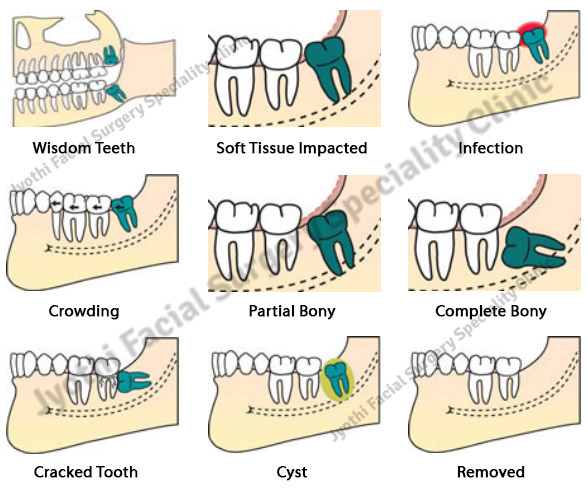

Third molars, commonly referred to as wisdom teeth, are usually the last four of 32 teeth to erupt (surface) in the mouth, generally making their appearance between the ages of 17 to 25. They are located at the back of the mouth (top and bottom), near the entrance to the throat. The term “wisdom” stems from the idea that the molars surface at a time typically associated with increased maturity or “wisdom”. The removal of third molars is one of the most common procedures performed by an oral and maxillofacial surgeon. They are the reason most people first visit an oral surgeon.
In most cases, inadequate space in the mouth does not allow the wisdom teeth to erupt properly and become fully functional. When this happens, the tooth can become impacted (stuck) in an undesirable or potentially harmful position. Greater than 90% of the population has or has had at least one impacted tooth.

Problems arising from impacted teeth include pain, infection, crowding of teeth, loss of bone and gums, damage to adjacent teeth or other structures, and can contribute to health problems. Cyst or tumors may arise from a developing third molar requiring larger, more extensive surgery.
Third molar teeth do not need to be impacted to create problems. There is usually little or no function to wisdom teeth and due to their position in the mouth, can be difficult to keep clean. Without complete eruption of wisdom teeth and healthy gums surrounding them, pockets collecting debris and bacteria increase the chance for infection. Pain is a common complaint during eruption and can be severe. Complications are difficult to predict; the longer the wisdom teeth remain the more likely they are to cause problems. The best prevention is removal of wisdom teeth during the teen years.
A short consultation involving an oral and radiographic exam should be done to evaluate the position of the wisdom teeth and potential problems. Surgeon will explain the procedure and the recovery from wisdom teeth extraction as well as answer any questions you may have.
The optimal time to remove wisdom teeth is usually in the mid teenage years; root development is not complete and removal creates less discomfort and a quicker recovery. Healing and overall outcome is improved.
There are several types, or degrees, of impaction based on the actual depth of the teeth within the jaw:
Soft Tissue Impaction: The upper portion of the tooth (the crown) has penetrated through the bone, but the gingiva (gum) is covering part or all of the tooth’s crown and has not positioned properly around the tooth. Because it is difficult to keep the area clean, food can become trapped below the gum and cause an infection and/or tooth decay, resulting in pain and swelling.
Partial Bony Impaction: The tooth has partially erupted, but a portion of the crown remains submerged below the gum and surrounding jawbone. Again, because it is difficult to keep the area clean, infection will commonly occur.
Complete Bony Impaction: The tooth is completely encased by jawbone. This will require more complex removal techniques.
While not all wisdom teeth require removal, wisdom teeth extractions are most often performed because of an active problem such as pain, swelling, decay or infection, or as a preventative measure to avoid serious problems in the future. If impaction of one or more wisdom teeth is present, and left untreated, a number of potentially harmful outcomes can occur, including:
Damage to nearby teeth: Second molars (the teeth directly in front of the wisdom teeth) can be adversely affected by impacted wisdom teeth, resulting in tooth decay (cavities), periodontal disease (gum disease) and possible bone loss.
Disease: Although uncommon, cysts and tumors can occur in the areas surrounding impacted wisdom teeth.
Infection: Bacteria and food can become trapped under the gum tissue, resulting in an infection. The infection can cause considerable pain and danger.
Tooth Crowding: It has been theorized that impacted wisdom teeth can put pressure on other teeth and cause them to become misaligned (crowded or twisted). This theory isn’t universally accepted by all dental professionals, and it has never been validated by any scientific studies.
As with any dental procedure, your Surgeon will want to initially conduct a thorough examination of the wisdom and surrounding teeth. Panoramic or digital x-rays will be taken in to evaluate the position of the wisdom teeth and determine if a current problem exists, or the likelihood of any potential future problems. The x-rays can also expose additional risk factors, such as deterioration or decay of nearby teeth. Early evaluation and treatment (typically in the mid-teen years) is recommended in order to identify potential problems and to improve the results for patients requiring wisdom teeth extractions. Only after a thorough examination can your dentist provide you with the best options for your particular case.
Wisdom teeth removal is a common procedure, generally performed under local anesthesia, intravenous (IV) sedation, or general anesthesia by a specially trained oral and maxillofacial surgeon in an office surgery suite. The surgery does not require an overnight stay, and you will be released with post-operative instructions and medication (if necessary), to help manage any swelling or discomfort.